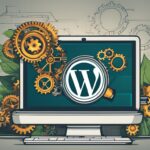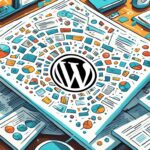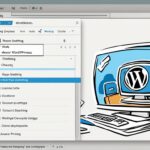Table of Contents
Welcome to our comprehensive guide on how to speed up your WordPress website and enhance its performance to deliver an exceptional user experience. We understand that a slow-loading site can be frustrating for visitors and detrimental to your search engine rankings.
Did you know that website speed is a critical factor that affects user satisfaction and conversions? Studies have shown that even a one-second delay in page load time can result in a significant drop in customer satisfaction and increased bounce rates. Moreover, search engines like Google consider page speed as one of the ranking factors, making it imperative to optimize your WordPress site for speed.
In this article, we will delve into the importance of website speed and its impact on user experience and search engine rankings. We will provide you with practical and actionable tips on how to tackle the factors that slow down your WordPress site. From choosing a reliable hosting provider to optimizing your WordPress configuration, we’ve got you covered. We will also guide you on how to optimize page size and images, fine-tune WordPress for speed, and utilize advanced tools and techniques to maximize performance.
Remember, a fast-loading WordPress site not only improves user experience and SEO rankings but also increases conversion rates. So let’s dive in and discover the quick tips to speed up your WordPress site and provide an exceptional user experience!
Understanding the Factors that Slow Down Your WordPress Site
When it comes to WordPress site performance, several factors can have a significant impact on loading speed. By understanding these factors, you can effectively optimize your site for speed and provide a better user experience. In this section, we will delve into each of these factors and provide actionable steps to address them.
Web Hosting
Your choice of web hosting provider can greatly affect the performance of your WordPress site. Shared hosting plans, while cost-effective, often result in slower loading times due to shared server resources among multiple websites. On the other hand, dedicated hosting or managed WordPress hosting plans offer better performance and can handle increased traffic without compromising load times. It is essential to choose a reliable hosting provider that aligns with your performance requirements.
WordPress Configuration
The configuration of your WordPress site can also impact its speed. Poorly configured caching settings, content delivery networks (CDNs), and database optimization can lead to slow-loading pages. By implementing caching plugins, utilizing CDNs to deliver content from geographically closer servers, and optimizing your database, you can significantly improve your site’s performance.
Page Size
The size of your web pages can affect the loading speed. Large page sizes result in longer load times, especially for visitors with slower internet connections. It is crucial to optimize your web pages by minimizing unnecessary elements, compressing files, and utilizing lazy loading techniques to defer the loading of non-visible images and videos.
Poorly Coded Plugins and External Scripts
Using poorly coded plugins or adding too many external scripts can also contribute to slow-loading pages. It is essential to carefully select and regularly update plugins, ensuring they are optimized for performance. Additionally, minimize the use of external scripts and only include those necessary for your site’s functionality.
By addressing these factors affecting WordPress performance, you can improve your site’s loading speed and provide a seamless browsing experience for your visitors. In the next section, we will provide further insights into choosing a reliable hosting provider and optimizing your WordPress configuration.
| Factor | Impact on Performance |
|---|---|
| Web Hosting | Shared hosting plans may result in slower page loading due to shared server resources. |
| WordPress Configuration | Poorly configured caching, CDNs, and database settings can lead to slow-loading pages. |
| Page Size | Larger page sizes result in longer load times, especially for visitors with slower internet connections. |
| Poorly Coded Plugins and External Scripts | Using poorly coded plugins or too many external scripts can contribute to slower loading speeds. |
Choosing a Reliable Hosting Provider
In today’s digital landscape, selecting a reliable hosting provider is paramount to ensuring optimal website performance. The hosting provider you choose can directly impact your website’s speed and overall user experience. Let’s explore the key factors to consider when selecting a hosting provider and examine the different hosting options available.
The Importance of Server Resources
When it comes to website speed, server resources play a crucial role. With shared hosting, multiple websites share server resources, including CPU power, RAM, and bandwidth. While shared hosting plans can be cost-effective, they may result in slower loading times during peak traffic periods when server resources are stretched thin.
Alternatively, dedicated hosting or managed WordPress hosting plans provide dedicated server resources, guaranteeing faster loading times and improved performance. With dedicated hosting, you have complete control over server resources, allowing your website to handle high traffic volumes without compromising load time.
Shared hosting is a popular choice for small websites or blogs starting their online presence. It offers affordability and simplicity, making it an attractive option for beginners. However, it may not be the best choice if you anticipate significant growth or have high-performance requirements.
Dedicated hosting, on the other hand, is the ideal solution for websites with heavy traffic, resource-intensive applications, or eCommerce platforms. It provides maximum control, security, and scalability, ensuring optimum performance even under high loads. Additionally, managed WordPress hosting specifically caters to WordPress sites, offering enhanced speed, automatic updates, and expert support tailored to the platform.
Choosing the Right Hosting Provider
When selecting a hosting provider, consider the following factors:
- Reputation: Opt for a reputable hosting provider with a strong track record of reliable service and positive customer reviews.
- Uptime Guarantee: Look for a hosting provider that offers a high uptime guarantee, ensuring your website is accessible to visitors at all times.
- Support: Evaluate the level of technical support provided, including 24/7 availability and expertise in WordPress hosting.
- Scalability: Choose a hosting provider that allows easy scalability as your website grows, ensuring seamless performance.
- Security Measures: Prioritize hosting providers that offer robust security measures, such as SSL certificates, firewalls, and regular backups.
By carefully considering these factors and thoroughly researching hosting providers, you can select a reliable provider that meets your website’s speed and performance requirements.
Remember, choosing a reliable hosting provider is a critical step in optimizing your website’s speed and overall performance. Don’t underestimate the impact of server resources and hosting options on your user experience. Take the time to make an informed decision and ensure your website provides a fast and seamless browsing experience for your visitors.
Optimizing WordPress Configuration
Optimizing your WordPress configuration can significantly improve website speed. By implementing the following techniques, you can enhance your WordPress site’s performance and provide faster load times for your users.
Caching Plugins
Utilizing caching plugins, such as WP Rocket or WP Super Cache, can greatly reduce server processing time. These plugins create cached versions of your pages, allowing them to be delivered quickly to users, resulting in enhanced performance. By implementing caching plugins, you can optimize your WordPress site for speed and provide a seamless browsing experience.
Content Delivery Network (CDN)
A content delivery network (CDN) is another effective way to improve website speed. CDNs help deliver your website content from geographically closer servers, reducing the distance data needs to travel. This minimizes load times and ensures faster page delivery to users regardless of their geographical location. By integrating a CDN into your WordPress site, you can provide a faster and more consistent user experience.
Lazy Loading
Lazy loading is a technique that defers the loading of non-visible images and videos until they come into view. This helps reduce the initial page load times, as only the necessary content is loaded initially. By implementing lazy loading, you can enhance website speed and improve user experience. Users will be able to access the main content quickly while non-visible media elements load in the background.
Database Optimization
Optimizing your WordPress database is crucial for improving website performance. Some techniques for database optimization include limiting post revisions, disabling pingbacks and trackbacks, and removing unnecessary data. By reducing the size and complexity of your database, you can minimize server processing time and achieve faster load times for your website.
| Technique | Benefits |
|---|---|
| Limiting post revisions | Reduces database size and improves database queries |
| Disabling pingbacks and trackbacks | Declutters the database and reduces server load |
| Removing unnecessary data | Improves overall database performance and speed |
Optimizing Page Size and Images
Large page sizes and unoptimized images can negatively impact the speed and performance of your WordPress site. In this section, we will explore key techniques to optimize page size and images, ultimately improving the user experience and load times.
Image Optimization
One of the most effective ways to optimize your website is by optimizing your images. By reducing the file size without compromising on quality, you can significantly enhance the loading speed of your pages.
Image compression is a popular method to achieve this. Here are a few recommendations and tools to optimize your images:
- Image compression plugins: Plugins like Smush and Imagify can automatically compress and optimize images upon upload. They utilize advanced algorithms to reduce file sizes while maintaining visual quality.
- Manual image optimization: If you prefer a more hands-on approach, you can use online tools like TinyPNG or JPEGmini to compress images before uploading them to your WordPress site.
Remember to keep an eye on the file format as well. JPEG files are generally more suitable for images with complex color schemes, while PNG files are ideal for graphics, logos, and images with transparent backgrounds.
Lazy Loading Images
Lazy loading is another valuable technique to optimize your website’s performance. By implementing lazy loading, images are only loaded when they become visible to the user, reducing the initial page load time.
When implementing lazy loading, consider the following options:
- Lazy loading plugins: WordPress plugins like Lazy Load by WP Rocket or a3 Lazy Load can enable lazy loading functionality on your site with just a few clicks.
- Manually adding lazy loading: For more control over your lazy loading implementation, you can use JavaScript libraries like LazyLoad or Intersection Observer to add lazy loading to your WordPress themes.
By optimizing your images and implementing lazy loading, you can significantly improve your website’s speed and user experience. Now, let’s move on to fine-tuning your WordPress site for even better performance.
Fine-Tuning WordPress for Speed
Fine-tuning your WordPress site is crucial in achieving optimal speed and performance. By implementing advanced optimization techniques, you can further enhance your website’s speed and deliver a seamless browsing experience for your visitors.
Splitting Long Posts
If you have lengthy articles or content-heavy pages, consider splitting them into multiple pages. This reduces the initial load time and improves overall page speed. Users can navigate through the content more easily without waiting for a large page to load fully. Utilize the WordPress pagination feature or plugins specifically designed for splitting long posts.
Reducing External HTTP Requests
Reducing the number of external HTTP requests can significantly improve your WordPress site’s speed. Each request made to external resources, such as CSS files, JavaScript files, or images, adds to the overall load time. Optimize your site by minimizing the use of external scripts and consolidating CSS and JavaScript files. This reduces the number of requests and decreases the time it takes for your pages to fully load.
Optimizing Database Calls
Database optimization is essential for improving WordPress performance. Reduce the number of unnecessary database calls by optimizing your WordPress queries. Utilize caching plugins that store database query results and serve them without the need for repeated database calls. Also, ensure that your database is properly indexed, as this can significantly speed up query execution.
Reducing File Sizes
Large file sizes can slow down your website’s load time. Compressing files, such as images, CSS, and JavaScript, reduces their size without compromising quality. Use image optimization plugins that automatically compress and optimize images upon upload. Additionally, leverage file compression tools to reduce the size of CSS and JavaScript files. This reduces bandwidth usage and minimizes load times.
By fine-tuning WordPress for speed and implementing these strategies, you can optimize your site’s performance, reduce HTTP requests, optimize database calls, and decrease file sizes. Remember, a faster website leads to better user experience, improved search engine rankings, and increased conversions.
Implementing these strategies can enhance website performance and deliver faster load times to your visitors.
Utilizing Advanced WordPress Tools and Techniques
When it comes to improving website speed and security, advanced WordPress tools and techniques can make a significant impact. In this section, we will explore two crucial aspects of optimizing your WordPress site: utilizing a DNS level website firewall and fixing HTTPS/SSL errors.
Protect Your Site with a DNS Level Website Firewall
A DNS level website firewall acts as the first line of defense against various online threats, including malicious attacks and unauthorized access attempts. By implementing a DNS level firewall, you can safeguard your site’s data, enhance performance, and provide a secure browsing experience for your visitors.
A DNS level website firewall operates by redirecting your site’s traffic through a secure network, filtering out potential threats, and only allowing legitimate requests to reach your server. With this added layer of protection, you can effectively minimize the risk of cyberattacks and ensure uninterrupted functionality of your WordPress site.
Fixing HTTPS/SSL Errors for Secure Connections
HTTPS/SSL encryption is crucial for establishing secure connections and safeguarding user data on your WordPress site. However, HTTPS/SSL errors can occur and may result in potential browser warnings, negatively impacting user trust and site credibility.
To fix HTTPS/SSL errors, it is essential to diagnose the underlying issues and implement appropriate solutions. Common error types include expired or invalid SSL certificates, mixed content warnings, and improper server configurations.
By resolving these errors, you can ensure that your WordPress site is secure and free from potential vulnerabilities that could compromise user data and trust.
To fix HTTPS/SSL errors, consider the following:
- Check SSL certificate validity and renew if required.
- Ensure all resources on your site, including images, scripts, and stylesheets, are loaded over secure HTTPS connections to avoid mixed content warnings.
- Review server configurations to ensure proper SSL/TLS protocols and ciphers are enabled.
By resolving HTTPS/SSL errors, you establish a secure browsing environment for your visitors and prevent any potential browser warnings that may deter users from accessing your site.
Summary
Utilizing advanced WordPress tools and techniques, such as DNS level website firewalls and fixing HTTPS/SSL errors, can significantly enhance website speed and security. By implementing these measures, you protect your site from threats, ensure secure connections, and provide a seamless browsing experience for your visitors.
Conclusion
Optimizing your WordPress site for speed is crucial for enhancing user experience, improving search engine rankings, and increasing conversions. Slow-loading pages can lead to higher bounce rates, lower conversions, and reduced customer satisfaction. Google considers page speed as a ranking factor, making it essential to prioritize WordPress performance optimization.
By implementing the tips and techniques mentioned in this article, such as choosing a reliable hosting provider, optimizing WordPress configuration, optimizing page size and images, and fine-tuning WordPress for speed, you can significantly improve your WordPress site’s performance.
Remember that website speed is an ongoing process. Regular monitoring, optimization, and further fine-tuning are essential to maintain optimal performance. Continuously analyze website speed and user experience metrics to identify areas for improvement and apply adjustments accordingly. By prioritizing website speed, you can provide visitors with a seamless browsing experience, improve SEO rankings, and ultimately achieve your conversion goals.
FAQ
Why is website speed important for a WordPress site?
Website speed is crucial for a WordPress site because it directly impacts user experience and search engine rankings. Slow-loading pages can lead to higher bounce rates, lower conversions, and reduced customer satisfaction. Additionally, Google considers page speed as a ranking factor, so optimizing your WordPress site for speed is essential.
What factors can slow down a WordPress site?
Several factors can slow down a WordPress site, including web hosting, WordPress configuration, page size, poorly coded plugins, and external scripts.
How can I choose a reliable hosting provider for my WordPress site?
When choosing a hosting provider, it is crucial to consider the server resources, as shared hosting plans can result in slower loading times if resources are shared among many websites. Dedicated hosting or managed WordPress hosting plans offer better performance and can handle increased traffic without affecting load time.
What are some ways to optimize WordPress configuration for better speed?
Optimizing WordPress configuration can significantly improve website speed. Some techniques include using caching plugins to create cached versions of your pages, utilizing content delivery networks (CDNs) to deliver content from geographically closer servers, implementing lazy loading to defer loading images and videos until they come into view, and optimizing the database by limiting post revisions and disabling pingbacks and trackbacks.
How can I optimize page size and images on my WordPress site?
To optimize page size and images, you can compress images without sacrificing quality to reduce file size. Implementing lazy loading images can also improve initial page load times by only loading images visible to the user.
Are there any advanced optimization techniques for WordPress speed?
Yes, there are advanced optimization techniques for WordPress speed. These include splitting long posts into multiple pages, reducing external HTTP requests, optimizing database calls, and reducing file sizes, all of which can further enhance website performance.
What are some advanced tools and techniques for improving WordPress speed and security?
Some advanced tools and techniques for improving WordPress speed and security include using DNS level website firewalls to protect your site from threats and improve performance, as well as fixing HTTPS/SSL errors to ensure secure connections and prevent potential browser warnings.
How important is it to regularly monitor and optimize website speed?
Regular monitoring and optimization of website speed are essential to maintain optimal performance. Website speed is an ongoing process, and by implementing the tips and techniques mentioned in this article, you can significantly improve your WordPress site’s performance.












